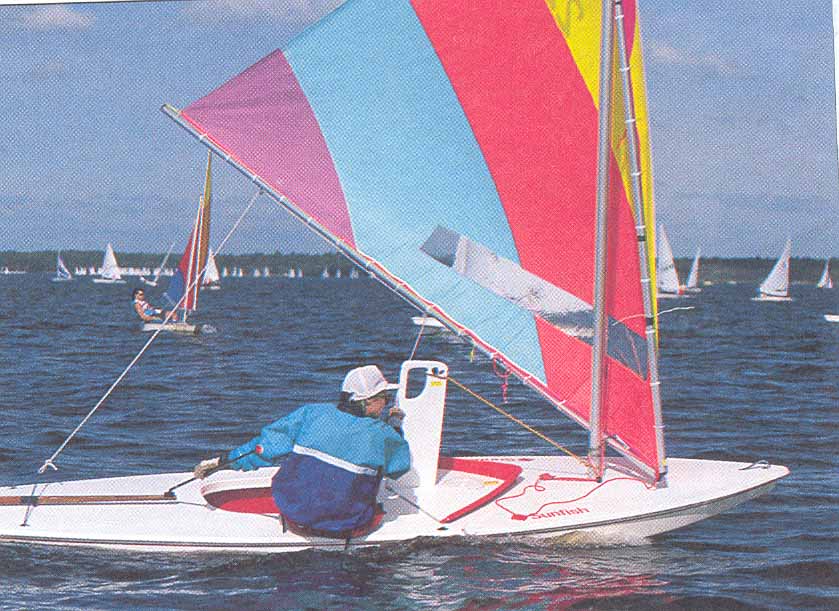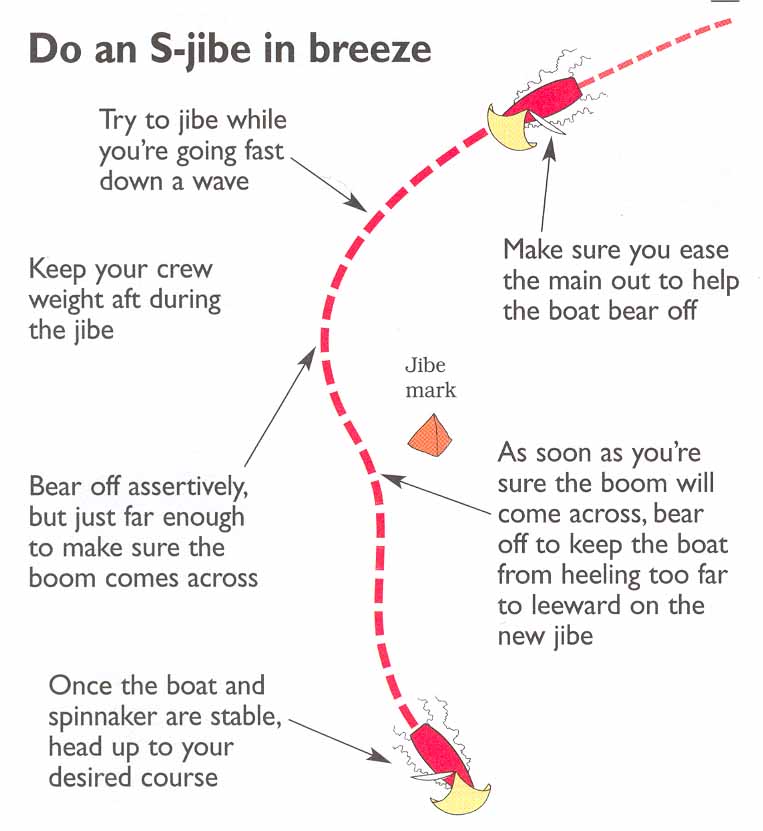
Turn Efficiently at the Jibe Mark
by David Dellenbaugh
Rounding the jibe mark is one of the most complex maneuvers you ever make on the race course. To get good at it, you must be skilled and practiced in your boathandling and sailhandling skills. These almost always make the difference between a mediocre rounding and a fast one where everything clicks.
 |
| When you want to bear off into a jibe, donít just throw the helm over. To keep the boat going fast, use both your weight and sail trim to turn the boat and minimize the amount you move the rudder. |
The key is adjusting the trim of your boat and sails as you jibe around the mark
amidst a fleet of boats. Itís not easy because you have to focus on your own
crew work and keep your head out of the boat at the same time. Here are some
suggestions for smoother, more efficient jibe mark roundings.
Turn with crew weight
As Iíve said many times, the key to fast turns of any type is minimizing the use
of your rudder and the associated drag. While this can be a challenge when
youíre dodging boats at the jibe mark, try to use other turning methods as much
as possible.
One good way to help turn your boat is by moving crew weight from side to side.
When you want to start bearing off into a jibe, for example, hike out and heel
the boat to windward (or at least minimize leeward heel). This will help the
boat carve a turn to leeward. As the boom comes across and you settle on a
course for the second reach, move your weight to the other side to flatten the
boat. Using your weight to turn is especially important in light air when your
sails are not much help.
 |
| When itís windy, a key to good jibes with an asymmetrical chute is to start jibing the spinnaker earlier in your turn than you think. As soon as you start to bear off (and ease the mainsheet), begin pulling hard on the windward spinnaker sheet. Donít throw the boom over or turn the boat too far until the spinnaker clew gets at least to the headstay (assuming your spinnaker sheet is led inside). By getting the spinnaker this far around before you jibe, it will be easier to fill the sail quickly on the new tack. |
The epitome of using your weight to help turn the boat through a jibe is a ďroll
jibe.Ē This technique works best in light to medium wind and lighter boats with
round bottoms that are easily ďrolledĒ by the weight of the crew. Itís also
particularly effective for reach-to-reach jibes. However, when you are flying a
spinnaker, itís difficult to do a big roll jibe, so make flawless spinnaker
handling your priority; when you achieve this, slowly work on adding some roll.
A roll jibe is similar to the jibe we just described using your weight, except
the rolls to windward and back up again are more aggressive and pronounced. The
basic idea is to roll your boat as far as possible before the jibe and then
flatten it sharply after the boom comes over. If done right, this will help
eliminate the speed youíd otherwise lose in a jibe. Remember, however, that
although roll jibing is a kinetic exception permitted by rule 42, you are not
allowed to come out of a jibe faster than you went into it.
Turn the boat using sail trim
Another important method of turning your boat is by adjusting your sail trim.
When you want to bear off into a jibe, for example, you should ease out your
mainsail. This relieves leeward pressure on the aft part of the boat and allows
the bow to turn away from the wind more easily (without requiring a lot of
rudder to make this happen).
Unfortunately, easing the mainsheet when you start into a jibe is the opposite
of what often happens. Many skippers begin a jibe by bearing off and
simultaneously trimming in the main. This is wrong for at least two reasons.
First, trimming the main makes the boat want to head toward the wind, not away
from it, so this means you must use more rudder to bear off. Second, the best
way to keep going fast as you bear off is to ease the main out farther so the
wind keeps pushing on it; if you trim it in you lose power.
When and how to pull the main across
Getting the main and boom across the boat can be a critical part of any jibe,
especially in strong breeze when bad technique or hesitation can cause a broach
or capsize. The key is knowing exactly when to start pulling the main across and
then doing it assertively.
There are several signs that tell you when itís time to bring the boom over. One
is a fidgety mainsail leech, which shows the wind is starting to flow around the
back side of the mainsail. Another clue is reduced pressure on your mainsheet.
This is subtle, but itís a good indicator that the main is ready to change
sides.
 |
Once you know when to pull the main across, the only question left is how best
to do it. There are at least four techniques you can use, depending on the type
of boat youíre racing and the jibe youíre planning:
1) The helmsperson grabs all the mainsail parts together and pulls the boom
across.
Advantages: It gets the boom across quickly and at a precise moment. The boom
goes out quickly on the new jib,e which is good if youíre on a run.
Disadvantages: Not great when youíre jibing to a reach (as at a jibe mark)
because the main goes out too far. Not easy to trim the main in after the jibe.
2) A crewmember grabs the vang or the boom itself and throws the boom across.
Advantages: Same as above. Works well when helmsperson is too busy to pull boom
across.
Disadvantages: Same as above.
3) Skipper trims mainsheet through the block.
Advantages: Good for a reach-to-reach jibe because you can trim the sail as it
goes across the boat. Easy to trim main after the jibe.
Disadvantages: Takes longer to pull the sail in far enough to jibe. Less precise
timing of when it crosses.
4) Trimmer uses a winch to grind in the sheet.
Advantages: The only way to get boom in on big boats in breeze. Lets you hold
boom in middle of boat during jibe and ease it out slowly on new jibe.
Disadvantages: Takes a lot longer to pull the sail in far enough to jibe.
Usually requires two people.
Dave publishes the newsletter Speed & Smarts. For a subscription call:
800-356-2200 or go to
www.speedandsmarts.com